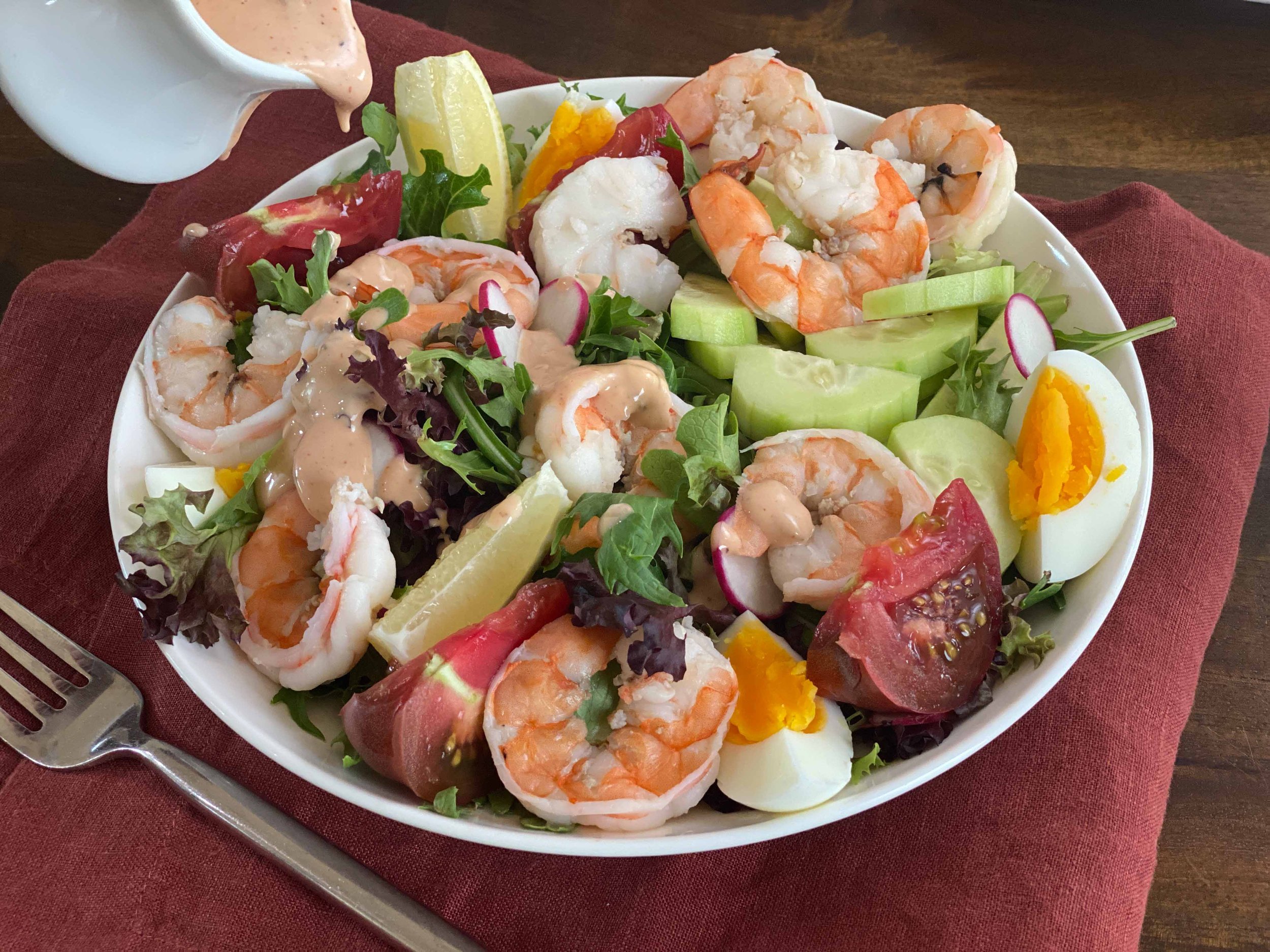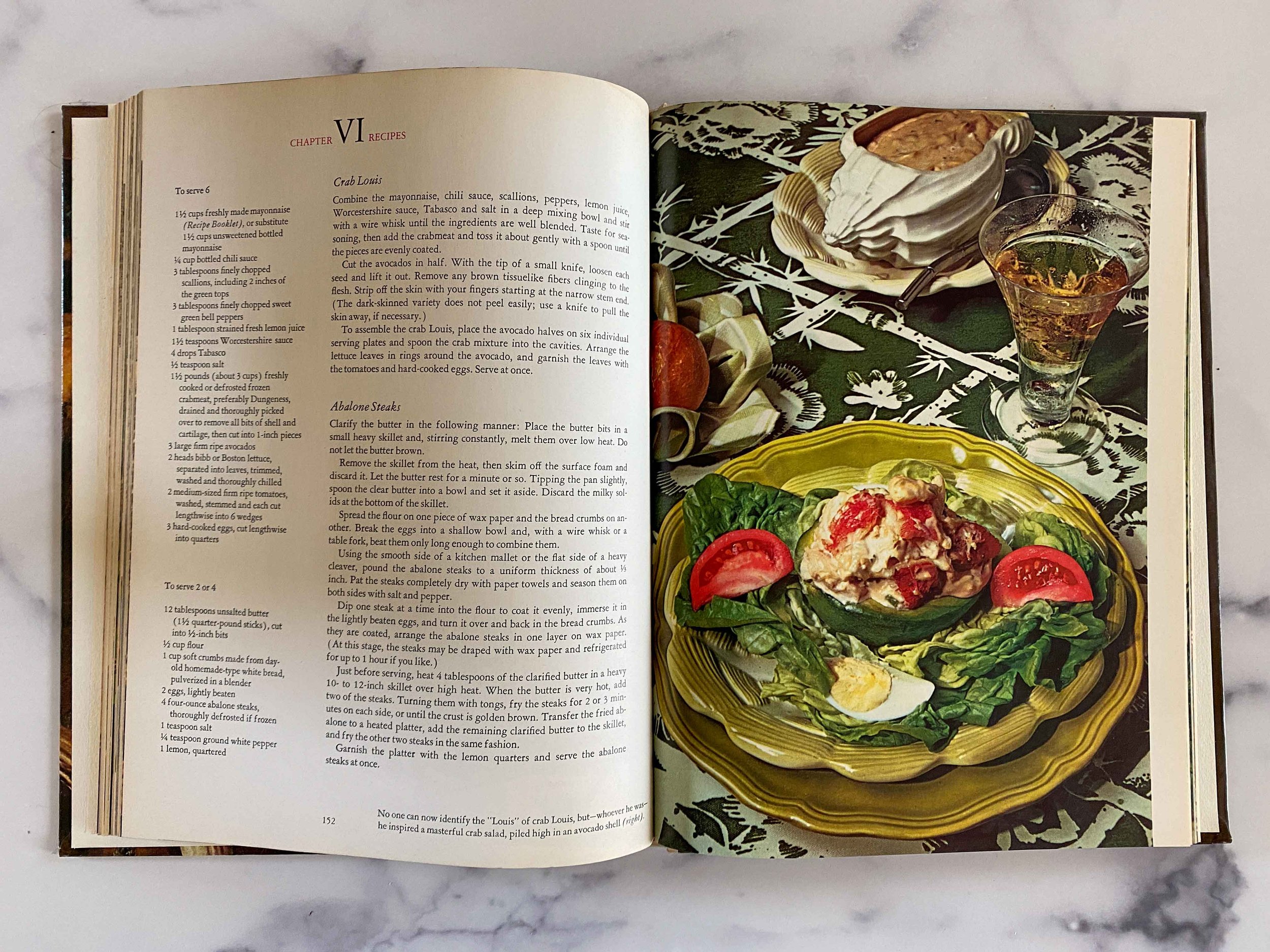By Leslie Brenner
When I was a seafood-loving child growing up in Los Angeles back in the late 1960s, one of my favorite family excursions was going to dinner on the Santa Monica Pier. About halfway out, on the south side of the pier, was a laid-back, checkered-tablecloth seafood joint that offered two of my favorite foods in the world. One was house-made potato chips that were crisp on the edges and soft in the middle. I can’t remember what they served them with, only that they were incredible.
The other was a seafood Louie. I may be rewriting history — that was a long time ago! — but the way I remember it, you could choose between Crab Louie, Shrimp Louie or Crab and Shrimp Louie. I always went for the the combo. What landed before me was a magnificent assemblage of iceberg lettuce, plump shrimps, pieces of Dungeness crab (in and out of the shell), tomato wedges, hard-boiled egg quarters, a wedge of lemon and a pitcher of Louis dressing. How royal!
Somehow, the Louie salad (also spelled Louis, like its sauce) has fallen out of fashion, but I’ve always kept it in my rotation: A shrimp Louie has always been one of my favorite summer dinners to make at home. It’s easy, it’s delicious, it’s satisfying and it’s cold.
Interested? Here’s the recipe.
On the rare occasions I have access to Dungeness crab, I’ll make it a crab Louis; otherwise shrimp is dandy. (I always buy wild shrimp rather than the farmed stuff from Southeast Asia, which often suffers from poor farming practices.)
You may be wondering, what is the origin of seafood Louie, and why have I never heard of it? Really it’s a West Coast/last century thing, so if you’re unfamiliar with it, it’s probably either because you’re younger, or not from the West Coast, or both.
History of the Crab Louis
The crab Louis dates back at least to the early 20th century; it was likely born either in Washington State or California’s Bay Area. Either would make sense, as both are home to delicious Dungeness crab.
The exact origin is hazy. It is known to have been served at the Olympic Club in Seattle in 1904, when — according to What’s Cooking America — the legendary opera singer Enrique Caruso kept ordering it “until none was left in the restaurant’s kitchen.”
But this excellent short documentary segment — “Cracking the Case of Crab Louie,” from a show called “Mossback’s Northwest” shown on Seattle’s local PBS station — debunks the Caruso tale, pointing out that Caruso never visited Seattle. The segment also points to the earliest known appearance of a recipe in the Pacific Northwest for Crab Louis: in the Portland Council of Jewish Women’s Neighborhood Cookbook, published in 1912. The recipe called for lettuce, crab meat, hard-boiled and a dressing made from oil, vinegar, ketchup, Worcestershire sauce, English mustard, salt and paprika. (Apparently those ladies did not keep kosher!)
The Davenport Hotel — some 270 miles inland from Seattle — is another possible birthplace. The hotel’s restaurant, The Palm Court, states on its website that its founder — Louis Davenport — had his chef, Edouard Mathieu, create it. It’s still on the Palm Court’s menu, “served according to the original recipe.” Interesting to note that as described on the menu, that signature dish has the same ingredients as our basic recipe — “Crisp butter lettuce topped with fresh Dungeness crab leg meat, hard-boiled eggs, tomatoes, and our famous housemade Louis dressing.”
San Francisco also lays claim to Crab Louis’ invention. In a 1914 book called Bohemian San Francisco, author Clarence E. Edwords gave a recipe for the Crab Louis from a restaurant called Solari’s. There’s no lettuce, tomato or hard-boiled egg involved; it’s just crabmeat dressed with Louis dressing: mayo, chili sauce, chow-chow, Worcestershire sauce and herbs. The St. Francis Hotel is sometimes mentioned in Crab Louis’ origin story as well.
Louis’ evolution
Although James Beard — who was a native of Portland, Oregon — adored Crab Louis and reportedly included recipes for it in at least three of his cookbooks, the salad had a hard time gaining traction away from the West Coast. Clementine Paddleford did not include it among the more than 600 recipes she collected for What America Eats, her exhaustive 1960 survey of dining habits across the country.
It was, however, in both Craig Claiborne’s 1961 The New York Times Cookbook and the 1964 edition of Joy of Cooking. Both were basically crabmeat mounded on lettuce, with Louis dressing spooned over.
A rendition included in Time-Life’s famous American Cooking series (“The Great West” edition, published in 1971) looks and sounds more enticing. This one has you toss crabmeat with the dressing and set the dressed crab in half an avocado, arrange bibb or Boston lettuce leaves around it and garnish with tomato and hard-boiled egg wedges.
Since then, written mentions of the salad — whether in books or on menus — are few and far between. Perhaps you can still find it here and there on the West Coast.
In 1996, I had the opportunity to cross the Atlantic on the Queen Elizabeth II, invited as a first-class passenger. That included dinners in the Queen’s Grill — where you could order whatever you wanted, whether or not it was on the menu. Everyone enjoyed playing “stump the kitchen,” but stumping those polished servers wasn’t so easy. One night I asked for a Crab Louis: Of all the things I could think of eating that moment, that sounded the best. The elegant waiter, who had seemingly never heard of the dish, nevertheless didn’t miss a beat. “Certainly, madame,” he said. “And how would you like that prepared?”
“Oh, the usual way,” I said. “A bed of Boston lettuce, with Dungeness crab heaped on top, wedges of tomato and hard-boiled egg, and that Louis dressing that’s pretty much a Thousand Island.” A few minutes later, a gorgeous one appeared. Absolutely royal.




